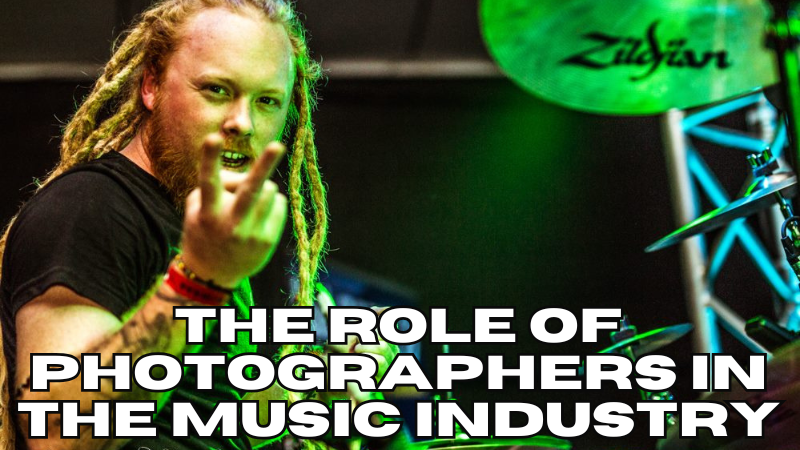
Photographers are the unsung storytellers of the music world, capturing moments that words often can’t express.
From the raw energy of live performances to the intimate behind-the-scenes shots, they document the essence of artists and their connection with fans.
Through their lens, photographers not only preserve music history but also help define the visual identity of music, making it an integral part of the cultural experience.
Key Takeaways:
- ★ Concert photography has evolved with technology, transitioning from film to digital, which allows for sharper, more dynamic images even in challenging lighting conditions.
- ★ Capturing live performances is an art, where photographers anticipate moments and turn chaos into compelling visual stories.
- ★ Photographers build long-term relationships with artists, creating intimate, evolving visuals that reflect the artist’s journey over time.
- ★ Iconic concert photos become cultural symbols, preserving defining moments in music history and shaping how we remember artists and eras.
- ★ The future of concert photography offers creative possibilities through new technologies like AI and drones, while also facing challenges around competition and ethical issues.

How Did Concert Photography Evolve?
Live music photography has come a long way, from its early days in print magazines to becoming an essential part of the digital age.
As the music industry has changed, photographers have adapted, embracing new technologies and reflecting the latest cultural trends.
How Did It All Begin?
Live music photography really began to take shape in the mid-20th century, when photographers started capturing performances for magazines and album covers.
Back then, access to shows was limited, and lighting was often a nightmare, but iconic photographers like Jim Marshall made their mark.
As rock ‘n’ roll took off in the ‘60s and ‘70s, photographers gained more access to legendary acts like The Beatles and Jimi Hendrix, immortalizing their performances.
Despite the technical hurdles, these early photos became key to music journalism, solidifying the link between live shows and storytelling through images.
How Has Technology Changed the Game?
The shift from film to digital photography in the 2000s was a game-changer.
Digital cameras made it possible to shoot in low light without losing image quality—something that was essential for live events.
Plus, improved stage lighting and the rise of digital editing software like Photoshop gave photographers more control and freedom to create stunning images.
These advances meant sharper, more dynamic shots that were once impossible to get, opening up all kinds of new creative possibilities.
What Happened When Music Photography Moved Online?
As the world went digital, music photography followed suit. Social media platforms like Instagram and Twitter made it easy for photographers to share their images instantly with global audiences.
Fans could now get a closer, more personal look at live events in real-time.
The rise of streaming services and live online broadcasts also created new platforms for photographers to showcase their work, making images a central part of how we experience music today.

Why Is Capturing Live Performances Such an Art?
Taking a great photo at a live show isn’t just about clicking the shutter—it’s about being in the right place at the right time and anticipating the magic.
It’s about embracing the chaos of the performance and turning it into a powerful story through images.
What Are the Challenges of Photographing Live Shows?
Live performances are full of challenges for photographers.
Lighting can change constantly, with stage lights flickering or shifting in color and intensity, which makes getting the perfect shot tricky.
Then, you’ve got the movement of both the performers and the crowd to deal with.
Concerts are fast-paced, and a great shot often comes down to split-second timing—being in the right spot while adjusting to venue limitations, tight spaces, and fluctuating technical conditions.
What’s It Like Behind the Scenes?
One of the coolest parts of being a live music photographer is the backstage access.
Photographers get to capture moments most fans never see—from candid shots of the artists to the behind-the-scenes energy of the crew.
These intimate photos tell a more complete story of the concert experience, giving fans a glimpse of what goes on before and after the show, and showcasing the personalities behind the music.

How Do Photographers Work with the Music Industry?
Photographers are key players in the music industry, working closely with artists and their teams to create visuals that enhance the artist’s brand and support promotional campaigns.
How Do Photographers Collaborate with Artists?
A photographer’s job is more than just taking cool pictures—they’re helping to shape how an artist is seen by the world.
Photographers collaborate with artists, managers, and labels to create a visual identity that reflects the artist’s style and energy.
Whether it’s album covers, promotional shots, or behind-the-scenes images, these visuals are a big part of telling the artist’s story.
Over time, long-term collaborations can evolve into more intimate, meaningful photos that capture the artist’s growth and journey.
How Do Photographers Build Long-Term Relationships with Artists?
One of the biggest rewards of live music photography is the opportunity to form lasting relationships with artists.
As photographers work with the same artists over time—through albums, tours, and milestones—they become trusted partners who know the artist’s style and personality.
These long-term connections lead to more authentic and impactful images, and they provide photographers with stability and recognition in the industry.
What Role Do Photographers Play in Marketing & Promotion?
Photographs from live performances are not just memories—they play a crucial role in an artist’s marketing strategy.
By capturing high-energy moments, photographers help fans connect with the artist on a deeper level, boosting engagement and helping the artist reach a wider audience through digital and traditional media.

Why Are These Images Cultural Icons?
Concert photos do more than capture a moment—they become part of music history.
Some images become iconic, representing not just the artist, but the cultural movements they were a part of.
How Do These Moments Preserve Music History?
Concert photos are essential for preserving music history.
They capture moments that define an era—like the debut of a groundbreaking song or an unforgettable live show.
These images serve as historical artifacts, helping future generations understand the significance of live performances, long after the music fades.
What Makes Certain Shots Iconic?
Some photos from live shows go beyond being just snapshots—they become iconic representations of entire movements.
Think of Jimi Hendrix’s guitar-burning moment at Woodstock or Kurt Cobain’s haunting shot during Nirvana’s final tour.
These photos don’t just freeze a moment; they embody the spirit of a whole generation and continue to influence music culture long after the show’s over.
How Do These Images Impact Music Culture?
A single image can capture the raw energy of a concert, making fans feel like they were right there in the crowd.
In today’s digital world, these photos bridge the gap between artist and audience, allowing fans to engage with their favorite musicians in a more personal way.
Over time, these iconic images help tell a broader cultural story, influencing how music is remembered and celebrated.

What Are the Rewards & Challenges of Live Music Photography?
Live music photography is an exciting, dynamic field, but it’s not without its challenges. The thrill of capturing iconic moments is balanced by tough working conditions and fierce competition.
What Are the Tough Working Conditions?
Being a live music photographer isn’t for the faint of heart.
Long hours, tight deadlines, and tough environments—like poor lighting, cramped spaces, and unpredictable weather—are all part of the job.
It’s also an incredibly competitive field, with many photographers chasing the same gigs and access. But for those who push through, the rewards are worth it.
What Makes Capturing the Perfect Shot So Rewarding?
For live music photographers, it’s about telling a story through images.
Capturing that perfect, fleeting moment—a shot that conveys the raw emotion of the performance—is incredibly satisfying.
When a photo resonates with fans, it’s a reminder of why photographers do what they do.
How Do Photographers Gain Recognition?
Breaking into the concert photography world isn’t easy. It takes years of hard work, building a portfolio, networking, and proving yourself in a competitive industry.
Standing out is key, and often photographers start small, working their way up.
But once a photographer gains recognition for consistent, high-quality work, career-defining opportunities open up.

What’s Next for Live Music Photography?
The future of concert photography is looking bright.
Social media continues to give fans a platform to share their own images, but professional photographers still play a crucial role in capturing exclusive, high-quality shots.
New technologies like AI, virtual reality, and drones are opening up fresh creative possibilities, and with that comes the potential for even more immersive concert experiences.
At the same time, sustainability, photographers’ rights, and fair working conditions are becoming increasingly important as the industry evolves.
Common Questions
How Do Photographers Decide Where to Position Themselves During a Live Performance?
Photographers typically scout the venue beforehand to identify the best angles and positions for capturing key moments.
They consider factors like stage layout, lighting, crowd dynamics, and the artist’s movements.
Photographers often need to think on their feet, quickly adjusting to the unfolding performance to capture the most compelling shots.
How Do Photographers Handle the Pressure of Capturing Live Performances in Front of Large Crowds?
The pressure comes from the fast-paced environment, tight deadlines, and high expectations to deliver stunning images on the spot.
Many photographers rely on their experience, preparation, and instincts to stay calm under pressure.
They also develop strategies to work efficiently, often shooting in bursts to ensure they capture the perfect moment.
What Ethical Considerations Do Photographers Need to Keep In Mind When Working With Artists?
Photographers must be respectful of the artist’s privacy and boundaries, especially during intimate or backstage moments.
They also need to navigate the balance between capturing raw, candid moments and respecting the artist’s consent.
Additionally, photographers must ensure they credit their work appropriately and honor any agreements related to image usage and distribution.
How Do Photographers Balance Creativity With Technical Limitations During a Live Performance?
While technical factors like lighting and venue constraints can be challenging, experienced photographers use creative techniques such as adjusting ISO, aperture, and shutter speed to work around them.
They also rely on their knowledge of the performance flow, anticipating key moments and adjusting their settings on the fly to maximize the artistic potential of the shot.
Can a Photographer’s Personal Style Influence How an Artist Is Visually Represented?
Absolutely. A photographer’s unique approach to composition, lighting, and storytelling can play a huge role in defining an artist’s visual identity.
Over time, photographers develop a signature style, which can make their images instantly recognizable and help solidify the artistic narrative that aligns with the musician’s persona.
In Conclusion
Photographers are vital players in the music industry, shaping how artists are perceived, celebrated, and remembered.
Through their unique ability to capture fleeting moments, they bring music to life visually, creating lasting cultural icons and memories for fans to cherish.
As the industry continues to evolve, photographers will remain essential in telling the ever-changing story of music, bridging the gap between artists and their audiences while preserving the magic of live performances for generations to come.



